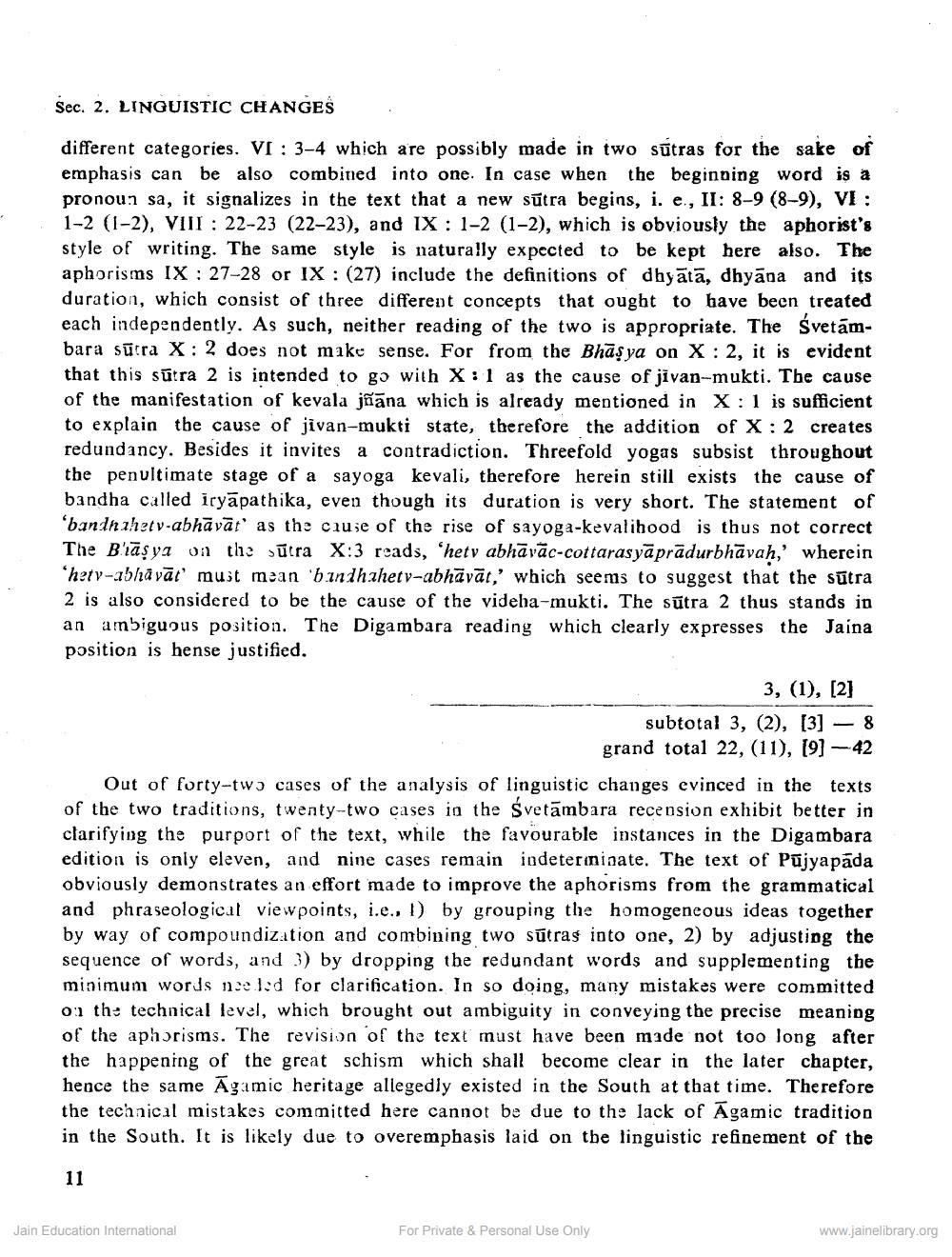________________
Sec. 2. LINGUISTIC CHANGES
different categories. VI: 3-4 which are possibly made in two sutras for the sake of emphasis can be also combined into one. In case when the beginning word is a pronoun sa, it signalizes in the text that a new sutra begins, i. e., II: 8-9 (8-9), VI: 1-2 (1-2), VIII: 22-23 (22-23), and IX: 1-2 (1-2), which is obviously the aphorist's style of writing. The same style is naturally expected to be kept here also. The aphorisms IX: 27-28 or IX: (27) include the definitions of dhyātā, dhyana and its duration, which consist of three different concepts that ought to have been treated each independently. As such, neither reading of the two is appropriate. The Svetambara sūtra X: 2 does not make sense. For from the Bhasya on X 2, it is evident that this sutra 2 is intended to go with X:1 as the cause of jivan-mukti. The cause of the manifestation of kevala jana which is already mentioned in X: 1 is sufficient to explain the cause of jivan-mukti state, therefore the addition of X: 2 creates redundancy. Besides it invites a contradiction. Threefold yogas subsist throughout the penultimate stage of a sayoga kevali, therefore herein still exists the cause of bandha called iryapathika, even though its duration is very short. The statement of 'bandnahetv-abhāvāt as the cause of the rise of sayoga-kevalihood is thus not correct The Biafya on the sutra X:3 reads, "hetv abhäväc-cottarasyäprädurbhavaḥ,' wherein 'hetv-abhavat' must mean 'bandhahetv-abhavat,' which seems to suggest that the sutra 2 is also considered to be the cause of the videha-mukti. The sūtra 2 thus stands in an ambiguous position. The Digambara reading which clearly expresses the Jaina position is hense justified.
Out of forty-two cases of the analysis of linguistic changes evinced in the texts of the two traditions, twenty-two cases in the Svetambara recension exhibit better in clarifying the purport of the text, while the favourable instances in the Digambara edition is only eleven, and nine cases remain indeterminate. The text of Pujyapāda obviously demonstrates an effort made to improve the aphorisms from the grammatical and phraseological viewpoints, i.e.. 1) by grouping the homogeneous ideas together by way of compoundization and combining two sutras into one, 2) by adjusting the sequence of words, and 3) by dropping the redundant words and supplementing the minimum words neeled for clarification. In so doing, many mistakes were committed on the technical level, which brought out ambiguity in conveying the precise meaning of the aphorisms. The revision of the text must have been made not too long after the happening of the great schism which shall become clear in the later chapter, hence the same Agamic heritage allegedly existed in the South at that time. Therefore. the technical mistakes committed here cannot be due to the lack of Agamic tradition in the South. It is likely due to overemphasis laid on the linguistic refinement of the
11
Jain Education International
3, (1), [2]
subtotal 3, (2), [3] — 8 grand total 22, (11), [9]-42
For Private & Personal Use Only
www.jainelibrary.org




